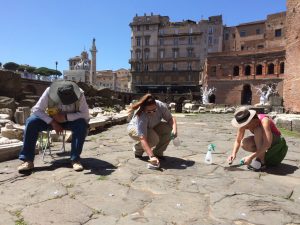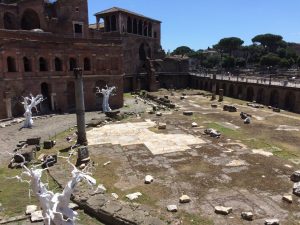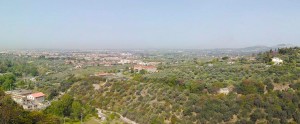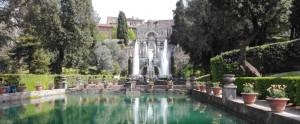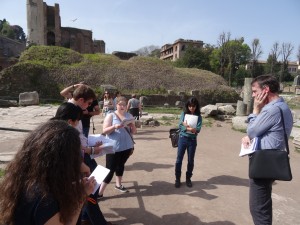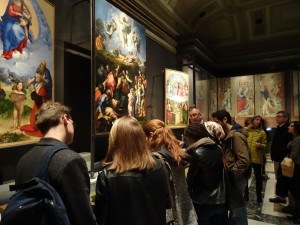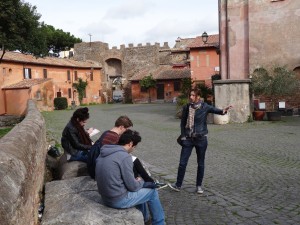We will continue to accept applications for the Academic year 2016-17 until end of August 2016
Kent’s Hi-Tech Archaeologists are working in Rome
A team of postgraduates are collecting new data in the Markets of Trajan adjacent to the Imperial Forum built by Trajan in the second century AD.
The data is collected with a portable Xray Flouresence (pXRF) analyser. This provides indications of the geo-chemical composition of paving stones from the site. In turn, this will allow researchers at the University of Kent to establish from which lava flow the stone was quarried. The machine is placed on each paving-stone for 90 seconds without any damage or destruction to the material.
Two PhD students taking part in this work, Julia Peters and Catherine Hoggarth, studied for their MAs in Rome, whilst Tabitha Rose is currently taking the MA. They will be working alongside a geologist, Mike Worthing and Lloyd Bosworth – the Department’s Archaeology Technician.
The project is led by Professor Ray Laurence and informs his research on Roman roads in Italy. His previous publications on this topic include The Roads of Roman Italy: Mobility and Cultural Change.
Professor Laurence commented: This work will provide us with new insights into the pattern of supply of stone for paving the streets of Rome. The team has worked hard to calibrate the equipment to replicate in the field, what might only be achieved in a large laboratory or via the destruction of archaeological materials. pXRF is a neat solution to provide a lot of data quickly using a small team.
Kent in Rome – Raphael events 2016
To coincide with the death of Raphael 496 years ago, the University of Kent held one of its annual European alumni events at the American University of Rome (AUR) on Wednesday 6 April 2016. This event was the second of a planned series of annual workshops building up to the 500th anniversary celebrations of Raphael’s death in 2020.
Two events took place at the University of Kent in Rome in April 2016; the first was a lecture delivered by Professor Arnold Nesselrath to mark the 496th anniversary of Raphael’s death, which presented the principal findings of the 30 year restoration campaign that he oversaw in the Raphael Stanze. This was then followed by a drinks reception. The next day, our Academic Director of Rome programmes, Professor Tom Henry, organised a study excursion to Tivoli for MA staff and students of Art History and Classics courses to mark the 500th anniversary of Raphael’s visit to Tivoli in April 1516. The study excursion visited the Sanctuary of Hercules Victor, the Villa d’Este and the Villa Adriana before returning to central Rome.
Professor Arnold Nesselrath’s lecture entitled “In the light of Raphael” focussed on how Raphael made use of light in different ways to convey emotion and depth. The lecture was well attended by AUR staff and students, alumni and University of Kent staff and was followed by a drinks and canape reception in the garden of AUR. This presented an excellent networking opportunity for guests to mingle and discuss the lecture over some delicious Roman catering!
The following day, the study excursion saw 35 students and staff board the coach to Tivoli, a city north-east of Rome. The first site we visited was the Sanctuary of Hercules Victor, only recently opened to the public in May 2015, located at the foot of Tivoli. Within the 3,000 square meters of the sanctuary is a large sacred area in the shape of a square, a theatre, and a temple which originally housed the statue of Hercules. The group then went on to the Villa d’Este, a Renaissance palace with stunning gardens and water fountains, which was originally built in 1550 for Cardinal Ippolito d’Este, the son of Lucrezia Borgia and Alfonso d’Este. The garden is designated a UNESCO World Heritage Site in recognition of its significance in the history of garden design, and its fountains find acclaim worldwide.
At this point, the group stopped for lunch at the Ristorante Sibilla, beside the Temple of Vesta. Lunch was served al fresco under a canopy of wisteria, looking out over the falls of the Aniene river in the blazing sunshine. Afterwards, the group walked around the Temple of Vesta and saw beautiful panoramic views down to the Villa Gregoriana. Our last visit was to the Villa Adriana, the site chosen by Emperor Hadrian for a huge palace set in acres of countryside. The group wandered around the extensive ruins which included a theatre, a stadium, many water features and thermal baths. Perhaps the most awe-inspiring site was the Canopus- a large rectangular pool measuring 121.4 metres long by 18 metres wide. The pool gained its name from an island in the Nile in Egypt that was the sanctuary of Serapis, the god of the Underworld, and is surrounded by chalk replicas of the original Roman copies of Greek sculptures from the Severa age.
Both the lecture and study excursion attracted a number of academics from various institutions, which provided a valuable opportunity for students and indeed staff to discuss what Raphael would have seen on his visit to Tivoli. Each location throughout the study excursion prompted a new area of discussion and encouraged future collaborations between AUR and the University of Kent; such as developing studies in Renaissance Art and Classics programmes.
Dr Philippa Jackson wrote that “the mixture of expertise of the professors, the ability to discuss across humanistic disciplines and periods, and the enthusiasm of all was an exemplary example of the importance of site visits and time for discussion which have always aided the development of such studies. As a cultural historian I was particularly interested in the archaeological knowledge imparted and a chance to discuss matters of the Renaissance in the light of the classical past. I would like to thank everyone involved in the arrangement of the lecture at the American university and the trip to Tivoli.”
Arrivederci Roma
Arrivederci Roma
The University of Kent in Rome Spring Term is over and we’ve said our goodbyes after a fabulous 12 weeks in Rome. Our 12 students were quickly into their strides with lectures and visits. We started all together in the Forum, and we ended all together at Tivoli – lunch under the purple wisteria at the Temple of Sibilla was spectacular (watch out for the video once it has been edited and uploaded on the Kent in Rome website!).
The Ancient Historians and Archaeologists were often in the Forum, and had been out to Tivoli earlier in the term with Dr Valerie Higgins, so they were well prepared. Prof Ray Laurence had also arranged a series of other visits, and they all attended the Roman Archaeology Conference in March.
Prof. Ray Laurence teaching in the Forum
Meanwhile the Art Historians had some astonishing visits: to the restoration scaffolds in front of Raphael’s frescoes in the Sala di Costantino in the Vatican, and to Raphael’s loggia and the Cappella Niccolina (all usually off-limits and all thanks to Prof Arnold Nesselrath), as well as to the rest of the Vatican Museums. We visited so many museums and churches and exhibitions across Rome, and the students’ end of term presentations in the church of S.M. della Pace were exemplary. Visits out of Rome to Ostia, Orvieto, Spello, Perugia and Florence were memorable, as was Kate Ganz’s tour of the Palazzo Farnese.
Prof. Tom Henry teaching ‘Raphael’ in the Vatican Museums
At the end of term Kent in Rome hosted a lecture by Prof. Arnold Nesselrath ‘In the light of Raphael’ and a study visit to Tivoli, 496 years after Raphael’s visit with Castiglione, Bembo and others. This visit – see also the report at https://www.kent.ac.uk/events/europe/rome.html – brought together students from all of our programmes, together with academics spanning the range of areas that we teach in order to create a dialogue between the Ancient Historians, Archaeologists and Art Historians.
We’ll be back in January 2017 with a new cohort of students, but for now, in the words of the song, it is: Arrivederci Roma!
Prof. T.F.K. Henry
Professor of History of Art
Director, University of Kent, Rome
www.kent.ac.uk/rome
The Art Historians in Ostia with Dr. Claudia La Malfa

